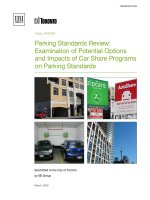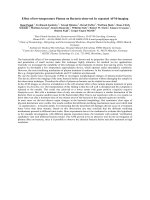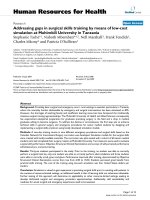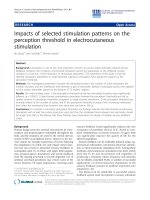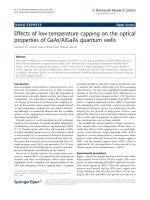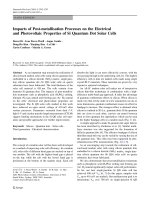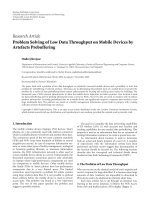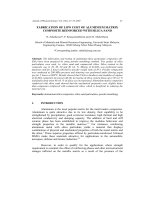Impacts of low cost carriers on singapore
Bạn đang xem bản rút gọn của tài liệu. Xem và tải ngay bản đầy đủ của tài liệu tại đây (2.39 MB, 158 trang )
IMPACTS OF LOW COST CARRIERS ON SINGAPORE
TEO CHOON HON
(B.Soc.Sci. (Hons), NUS)
A THESIS SUBMITTED FOR
THE DEGREE OF MASTER OF SOCIAL SCIENCES
DEPARTMENT OF GEOGRAPHY
NATIONAL UNIVERSITY OF SINGAPORE
2008
Impacts of Low Cost Carriers on Singapore
ACKNOWLEDGEMENTS
The decision to pursue this Masters degree was one that is fraught with many difficult
choices to make. A lot of sacrifices were made but I am glad to have embarked on this
journey and benefited from it. There were many challenges along the way but there
were as many rewards too. I hoped that the experiences gained from writing this
thesis will prepare me well for my “next lap in life” as I pursue a career in the
education sector.
I would like to express my gratitude to the following people, without whom, this
thesis would not have been possible:
Associate Professor K. Raguraman for your kind supervision, critical
comments and proof reading. Thank you for your patience, encouragement
and faith in me. It has been a great pleasure to be your student in the various
modules that you have taught and as your supervisee for this thesis! My
interest in transport geography grew because of your inspiration and I look
forward to learning more from you in the future when I ponder over transport
issues!
All faculty members from the Department of Geography at NUS who have
taught me before – Professors Brenda Yeo, Henry Yeung; Associate
Professors Chang Tou Chuang, David Higgitt, Lu Xi Xi, Matthias Roth, Wong
Poh Poh; and Dr Wang Yi-Chen. Thank you for your concerns, advice and
constructive comments at one point or another during my academic sojourn in
NUS! In particular, I would like to give special thanks to Associate Professor
Wong Poh Poh whom I have learnt a lot from his undergraduate classes as
well as his supervision for my Bachelor’s thesis.
Ex-faculty members from the Department of Geography, NUS who have
taught me before as well as faculty members whom I have worked with at one
point or another throughout my graduate days – Associate Professor Peggy
Teo; Drs Park Bae Gyoon (with Seoul National University), Paul Barter (with
Lee Kuan Yew School of Public Policy) and Noorashikin Abdul Rahman.
Thank you for your guidance and concern.
Associate Professor Teofilo Daquila from the Southeast Asia Studies
Programme and Dr Asato Saito from the Department of Japanese Studies,
NUS. Both of you have been instrumental in shaping my undergraduate and
graduate studies in NUS and I thank the both of you for your useful comments
and suggestions when I was your student then.
Associate Professor Becky Loo from the Department of Geography at the
University of Hong Kong (HKU) for your constructive comments both during
my undergraduate exchange at HKU as well as for this thesis.
i
Impacts of Low Cost Carriers on Singapore
The administrative staff of the Department of Geography, NUS – Ms Wong
Lai Wa, Ms Pauline Lee, Mrs Chong Mui Gek, Mr Yong Sock Ming, Mr Tow
Fui and Mrs Irene Chee. Thanks for your excellent administrative support and
help.
My fellow current and former graduate students and friends – Songguang,
Daryl, Seng Lee, Desmond, Andie, Monica, Harng Luh, Brian, November and
Chih Yuan. Thanks for your support, encouragement and laughter!
The Geography Honours Class of 2005/2006 for the fantastic memories!
The NUS Geographical Society 37th and 38th Executive Committee for the fun,
laughter and camaraderie when I was the Publicity Secretary and Publications
Director respectively.
All my ex-teachers, especially Ms Kalyani Kausikan for your faith and trust in
me!
My students from both GE2018 The Biophysical Environment of Singapore
and GEK2001/SSA2202 Changing Landscapes of Singapore. I had the great
pleasure of teaching all of you in my capacity as graduate tutor.
All my anonymous survey respondents for taking the time to complete the
survey.
All my interview respondents for taking time off your busy schedule to fill me
up with your expertise in the field of air transport. Special thanks to Mr. James
Fong and Mr. Daniel Loo from the Civil Aviation Authority of Singapore for
supplying me with useful data for my analysis.
My two anonymous markers for your time in reading this thesis and giving
your critical comments and insights.
My parents for your unfailing love, care and concern showered upon me!
ii
Impacts of Low Cost Carriers on Singapore
TABLE OF CONTENTS
Page
Acknowledgements
i
Table of contents
iii
Summary
vi
List of figures
vii
List of plates
viii
List of tables
ix
CHAPTER ONE: INTRODUCTION AND BACKGROUND
1
1.1
1.2
1
4
5
5
1.3
1.4
1.5
Preamble
Low cost carriers and their development
1.2.1 Low cost carrier development in North America
1.2.2 Low cost carrier development in Europe
1.2.3 Low cost carrier development in Far East and Southeast
Asia
Air transport, low cost carriers and Geography: The relationship
Aims, objectives and significance of study
Outline of thesis
6
8
10
12
CHAPTER TWO: LITERATURE REVIEW AND STUDY
FRAMEWORK
14
2.1
2.2
14
14
2.3
2.4
2.5
Introduction
Academic writing on low cost carriers
2.2.1 Research on low cost carriers – understanding their key
economics and operations
2.2.2 Research on low cost carriers – understanding their
relationship with the external environment they are operating in
2.2.3 Research on low cost carriers – the need to understand
beyond the “western model”
Academic writing on air hubs, their Geography, and their
relationship with low cost carriers
Understanding the regulation in the air transport sector and their
impacts on the development of low cost carriers
Chapter summary
14
15
16
17
20
26
iii
Impacts of Low Cost Carriers on Singapore
CHAPTER THREE: THE DEVELOPMENT OF LOW COST
CARRIERS IN ASIA
3.1
3.2
3.3
3.4
3.5
3.6
Introduction
Economic Landscape of Far East and Southeast Asia
Development of low cost carriers in Far East and Southeast Asia
Background information on the individual low cost carriers in
Far East and Southeast Asia
3.4.1 Indonesia
3.4.2 Hong Kong S.A.R.
3.4.3 Macau S.A.R.
3.4.4 Malaysia
3.4.5 Philippines
3.4.6 Thailand
3.4.7 Singapore
3.4.8 Section summary
Background information on selected airports in the region
and their relationship with the low cost carriers
3.5.1 Soekarno-Hatta International Airport, Jakarta, Indonesia
3.5.2 Hong Kong International Airport, Hong Kong S.A.R.
3.5.3 Macau International Airport, Macau S.A.R.
3.5.4 Kuala Lumpur International Airport, Malaysia
3.5.5 Diosdadol Macapagal International Airport, Philippines
3.5.6 Suvarnabhumi Airport, Bangkok, Thailand; and
Don Mueang Airport, Bangkok, Thailand
3.5.7 Changi Airport, Singapore
3.5.8 Fifth freedom rights and the growth of low cost carriers
Chapter summary
27
27
28
29
35
35
36
38
39
40
41
43
45
46
46
48
50
51
53
54
56
58
59
CHAPTER FOUR: METHODOLOGY
61
4.1
4.2
4.3
4.4
4.5
4.6
4.7
4.8
61
62
64
69
70
70
72
4.9
Introduction
Designing a research plan and sourcing for data
Mapping airport networks
Flight frequency, schedule and volume
Physical examination of the airports
Large-scale quantitative and qualitative survey
In-depth interviews
A study framework for analysing the impacts and sustainability of
the low cost carrier industry
Chapter summary
74
76
CHAPTER FIVE: FINDINGS AND ANALYSIS
77
5.1
5.2
5.3
77
77
78
83
Introduction
Network analysis of LCCs serving Singapore
Overview of the spatial networks of LCCs
5.3.1 Detailed analysis of the spatial networks of LCCs
iv
Impacts of Low Cost Carriers on Singapore
5.4
5.5
5.6
Analysis of flight frequencies, volumes and schedules
Physical examination of the airports in the region and qualitative
interviews
Chapter summary
89
101
110
CHAPTER SIX: EVALUATION OF BUSINESS MODEL FOR LOW
COST CARRIERS ~ ANALYSIS OF THE SINGAPORE-BANGKOK
SECTOR
112
6.1
6.2
6.3
6.4
6.5
6.6
6.7
Introduction
Background on the business models of the low cost carriers
6.2.1 Air Asia (Thai Air Asia)
6.2.2 Valuair
6.2.3 Tiger Airways
6.2.4 Jetstar Asia
Methodology
Results and analysis
6.4.1 Responses
6.4.2 Categorisations and business models
6.4.3 The importance of selected frills
6.4.4 Reality strikes: the need to operate cost-effectively
The most preferred business model for LCCs
Travel experience and business model
Chapter summary
112
112
113
113
114
114
115
116
116
118
119
121
123
125
129
CHAPTER SEVEN: SUMMARY AND CONCLUSION
131
7.1
7.2
7.3
131
133
136
Summary
Implications of study and future research
Concluding comments
LIST OF REFERENCES
138
APPENDIX
147
v
Impacts of Low Cost Carriers on Singapore
SUMMARY
The Singapore government has responded quite positively to the development
of low cost carriers (LCCs) in recent years by developing the airport infrastructure
and adopting liberal traffic rights policies. It is anticipating a healthy growth of LCCs
here; and there is an expectation that the potential benefits brought about by them will
be significant. This study provides an analysis of the markets and networks of the
LCCs in Singapore and the impacts they make on the local air transport landscape.
This is done with comparative studies of other airports in the region, particularly those
in Southeast Asia which also cater to the LCCs. In addition, this research aims to
analyse the development of LCCs in Singapore and their potentials in increasing the
connectedness and connectivity of Singapore with the region. The frequency of flights
to the various destinations served by LCCs as well as the seat capacity (supply) of the
flights are calculated and analysed. New routings developed by the LCCs which are
previously not serviced by Full Service Carriers (FSCs) are also examined. The thesis
also aims to explore whether the Singapore government’s large spending in promoting
the LCC industry here is justified. Passengers’ opinions on the LCCs they prefer are
looked at as this will indirectly indicate the type of LCC which will thrive well in
Singapore. The Civil Aviation Authority of Singapore (CAAS) has devoted much
efforts and resources to promoting the LCC industry at Changi. Through a critical
review of the dynamics of the LCC industry and the nature of competition and trends
in travel patterns in this region, the study will determine if the expected growth of
LCC activities will materialise and what are the impacts we can expect from the
development of LCCs.
Keywords: Airports, Low cost carriers, Singapore, Southeast Asia, Far East Asia,
Spatial analysis
vi
Impacts of Low Cost Carriers on Singapore
LIST OF FIGURES
Page
1.1
1.2
2.1
2.2
2.3
3.1
4.1
4.2
5.1
5.2
5.3
5.4(a)
5.4(b)
5.5(a)
5.5(b)
5.6
The profitability of key players in the air transport chain:
estimation of return on capital employed, 1992 – 1996
Passengers carried on scheduled air services, 1997 – 2006
Point-to-point network (panel A) and hub-and-spoke network
(panel B)
Freedoms of Air
Simplified schematic representation of the Freedoms of Air
A notification excerpt from Oasis Hong Kong Airline’ website
announcing its shutdown and liquidation
Sample network map
Indicator system of impacts and sustainability of the LCC industry
Destinations served by Air Asia group to and from Singapore
Destinations served by Cebu Pacific Air to and from Singapore
Destinations served by Lion Air to and from Singapore
Destinations served by Jetstar group (Jetstar Asia and/or Valuair)
to and from Singapore
Destinations served by Jetstar group to and from Singapore
Destinations served by Tiger Airways to and from Singapore
Destinations served by Tiger Airways to and from Singapore
Destinations served by all LCCs to and from Singapore with
FSCs factored into the picture
1
2
19
22
23
37
67
76
79
80
80
81
81
82
82
83
vii
Impacts of Low Cost Carriers on Singapore
LIST OF PLATES
Page
3.1
3.2
3.3
3.4
3.5
3.6
3.7
3.8
3.9
3.10
3.11
5.1
5.2
5.3
5.4
5.5
5.6
A Lion Air Boeing 737-900ER berthed at Singapore Changi
Airport
Viva Macau Boeing 767 berthed at Macau International
Airport, Macau S.A.R.
The author and other passengers disembarking from an Air Asia
Airbus A320 which arrived at Diosdado Macapagal International
Airport, Clark, Philippines
A Cebu Pacific Airbus A320 berthed at Ninoy Aquino
International Airport, Manila, Philippines
A McDonnell Douglas MD82 aircraft belonging to One-Two-Go
on the tarmac of Chiang Mai International Airport, Thailand
Passengers boarding a Tiger Airways Airbus A320 berthed at
the Budget Terminal, Changi Airport, Singapore
Passengers taking outbound flights on LCCs queuing up for
boarding of buses which will ferry them to the remote gates at
which the LCC aircraft are berthed
Passengers waiting for their flight inside the departure hall of the
Low Cost Carrier Terminal at Kuala Lumpur International Airport
An Air Asia Airbus A320 berthed at Diosdado Macapagal
International Airport. The terminal building is in the background
A Thai Air Asia Boeing 737 berthed at a remote gate at
Suvarnabhumi Airport, Bangkok, Thailand
Check-in area at the Budget Terminal, Changi Airport, Singapore
After disembarkation, passengers have to walk on the tarmac from
the aircraft to the terminal building as seen at KLIA
The spacious and nicely furbished LCC terminal at KKIA
Passengers queuing up to take a bus to the remote parking bay
for Jetstar Asia’s flight back to Singapore from Hong Kong
Remote parking bay typically used by LCCs at the Macau
International Airport
A Thai Air Asia Boeing 737-300 parked at the remote parking
bay at Suvarnabhumi Airport
Immigration clearance at DMIA, the Philippines
36
39
40
41
43
45
50
53
54
56
58
102
103
104
106
108
109
viii
Impacts of Low Cost Carriers on Singapore
LIST OF TABLES
Page
1.1
3.1
3.2
4.1
4.2
4.3
5.1
5.2(a)
5.2(b)
5.2(c)
5.2(d)
5.2(e)
5.2(f)
5.3
5.4
5.5
6.1
6.2
6.3
6.4
6.5
Comparison of the characteristics of Low Cost Carrier and
Full Service Carrier
4
Low cost carriers operating in Far East and Southeast Asia
34
Passenger and Aircraft movements at Soekarno-Hatta International
Airport, Jakarta, Indonesia
47
Types of connections by the Low Cost Carriers between
June 2006 and June 2008
68
Destinations served by Low Cost Carriers and their distances from
Singapore
69
Interviewees for the research
73
Vistor Arrivals from January to June 2008
86
Flight schedules of Adam Air for July 2006 and July 2007
90
Flight schedules of Air Asia group for July 2006, July 2007 and
June 2008
91
Flight schedules of Cebu Pacific Air for July 2007 and June 2008 92
Flight schedules of Lion Mentari Airlines for July 2007 and June
2008
93
Flight schedules of Jetstar group for July 2006, July 2007 and
June 2008
94
Flight schedules of Tiger Airways for July 2006, July 2007 and
June 2008
96
Comparison of the percentage growth in the number of seats
supplied by the various LCCs flying to and from Singapore
96
Comparison of number of flights and seats between June 2006
and June 2008 for selected sectors
97
Aggregated Passenger Traffic on Low Cost Carriers
100
Average price passengers are willing to pay for topping-up of frills 117
Most important frill to a passenger flying a LCC
119
Average price passengers are willing to pay for Jetstar flights
on the Singapore-Bangkok sector
126
Average price passengers are willing to pay for Thai Air Asia
flights on the Singapore-Bangkok sector
127
Average price passengers are willing to pay for Tiger Airways
flights on the Singapore-Bangkok sector
128
ix
Impacts of Low Cost Carriers on Singapore
CHAPTER ONE: INTRODUCTION AND BACKGROUND
1.1
Preamble
For the last half a century, despite the rapid growth in demand for its services,
the air transport industry has remained marginally profitable, possessing a rather low
rate of return on the capital invested. In particular, airlines are the worst performing of
any of the individual sectors in the entire air transport chain (Figure 1.1) (Doganis,
2002: 5). Yet, many new airlines are sprouting over the last few years, and in
particular, in the Far East and Southeast Asia region of the world. For example,
between the years 2004 and 2008, there were thirteen new Low Cost Carriers (LCCs)
emerging in Southeast Asia alone.
Figure 1.1: The profitability of key players in the air transport chain: estimation of
return on capital employed, 1992 – 1996.
(Source: Spinetta, 2000, as cited in Doganis, 2002)
There is no simple reason to explain the above apparent contradiction between
the rapid growth in the number of airlines and the industry’s marginal profitability. In
1
Impacts of Low Cost Carriers on Singapore
general, it could be due to an increase in propensity to travel as worldwide affluence
is growing. The capability in economic terms is increasingly available as put forth by
Shearman (1992: 4), and this has enabled more people to increasingly travel across
and around the world. It is an inherent nature of man to have this curiosity and desire
to see and understand other places and cultures and air transport gives people the
opportunity to do so (ibid). In fact, air transport is arguably the only form of transport
that is three-dimensional (Bamford & Robinson, 1978: 42) since aircraft are not tied
to the surface and have the ability to fly over terrestrial obstacles which have been
important dividers of societies over space and time. This has certainly helped to
overcome the friction of distance, and providing added convenience and time savings
over other forms of transport.
In fact, over the last few decades, the air transport industry has increasingly
been playing a vital role in facilitating economic growth. Aviation transports some 2
billion passengers annually and 40% of interregional exports of goods (by value)
(ATAG, 2008). In addition, 40% of international tourists now travel by air (ibid). In
terms of worldwide passenger traffic, the growth has been tremendous: from 1.5
billion in 1997 to over 2.1 billion in 2006 (Figure 1.2) (ICAO, 2007).
Figure 1.2: Passengers carried on scheduled air services, 1997 – 2006
(Source: ICAO website, 2007)
2
Impacts of Low Cost Carriers on Singapore
Asia, being one of the economic regions which have achieved significant
growth rates over the last decade since the 1997 financial crisis, is currently a hotbed
for aviation activities. In particular, the densely populated region of Southeast Asia,
with over 500 million people, has seen tremendous growth in the aviation sector and
remains one of the most underserved aviation markets in the world with huge
potential for further growth. However, it is not unique from any other aviation region
in the world insofar as regulation of air services is concerned. The regulating
mechanism has hindered the growth in the aviation sector in this region although we
are seeing a gradually “opening up of the skies” in order to tap into this huge market
that is seen as a booster to many of the countries’ economic and trade master plans.
Without the deregulation of the aviation industry in the region, albeit a gradual and
rather slow one, the air travel market would not have seen such tremendous growth
over the last decade; and new entrants, most notably the low cost carriers (LCCs),
would have found it difficult to enter the market and create the significant waves
which many of them are now generating.
In fact, the entry of LCCs into the regional aviation industry is a force to be
reckoned with and a personal interest on the LCCs arose as the author wanted to
understand and find out why the LCCs in this region have become a sector of the
trade industry in which several regional governments have been actively promoting.
The following section will explain the rise of the LCCs in other parts of the world as
well as the development of the LCC market here in Far East and Southeast Asia. An
attempt will be made in Section 1.3 of this chapter to understand the relationship
between the growth of LCCs and geography as a discipline and why a geographical
perspective is useful to understanding the impacts made by LCCs on Singapore and in
the region.
3
Impacts of Low Cost Carriers on Singapore
1.2
Low cost carriers and their development
In order to understand the development of LCCs, it is important to understand
what these carriers are and how they differ from a conventional Full Service Carrier
(FSC). To show the contrast, the author will provide a simple classification table to
illustrate what exactly a LCC is in terms of its characteristics and compare it with that
of a FSC. Table 1.1 below is an adaptation from McKechnie et al.’s (2007) work on
the potential in the growth of the LCC industry in the Middle East.
Low Cost Carrier
Simple brand – low-fare
Online and direct booking
Simple ticket price structure and ticketless check-in
Use of secondary or low-charging
airports (with exceptions)
High aircraft utilization
Point-to-point service with no interlining
Full Service Carrier
Complex brand – price + service
Mainly travel agents
Complex fare structures and tickets
produced for each booking
Focus on primary airports
Lower utilization of aircraft
Hub-and-spoke service with interlining as
one of the key focus
Simple product – additional services and Complex integrated service product(s)
facilities to be charged
Focus on ancillary revenue generation – Focus on primary product
e.g. onboard retailing and advertising
Mainly short-haul focus
Short and long haul
Common fleet type acquired at very good Mixed fleet
rates
Single class configuration
Cabins are divided into two or three
classes
No complimentary in-flight meals
Complimentary in-flight meals
Only operate core activities. Outsource Less outsourcing of operations
most operations
Table 1.1: Comparison of the characteristics of Low Cost Carrier and Full Service
Carrier
(Source: McKechnie et al., 2007)
From the table, we can see a distinction between the two types of carriers. For
example, their pricing mechanism is different such that LCCs tend to have simpler
fare structure and lowers fares as a result of the simple brand. Also, in terms of
4
Impacts of Low Cost Carriers on Singapore
operations, FSCs tend to operate using a hub-and-spoke network as compared to
point-to-point for LCCs. Cabin services differ too with the LCCs not offering frills
such as in-flight meal service when compared with the FSCs.
1.2.1
Low cost carrier development in North America
As mentioned in the previous section, the rise of LCCs has largely got to do
with the deregulation of the air transport industry. While the world’s first LCC,
Southwest Airlines, had actually started before the United States (US) 1978
Deregulation Act, it should be noted that without the deregulation, Southwest Airlines
might not have been that well-placed to expand beyond Texas (Doganis, 2001) where
it has been operating since it first started in 1971. The deregulation has helped, in one
way or another, Southwest Airlines to grow from a relatively small Texan intra-state
carrier into the fifth-largest US airline in 1999 in terms of domestic passengers. This
steady growth over nearly thirty years was also accompanied by consistent
profitability in every year of its operation (ibid).
Southwest Airlines was not the only LCC to have benefited from the
deregulation. The act itself has helped to spawn a number of the new LCCs eager to
profit from the lucrative airline business which had been virtually closed to new
entrants up to that point. These LCCs were highly innovative with no frills and cheap
fares as their selling points (Shearman, 1992: 87).
1.2.2
Low cost carrier development in Europe
Over in Europe, the LCC phenomenon is a much more recent and
revolutionary one. The LCC concept became established in Europe with the birth of
Ryanair, an independent Irish airline (Dobruszkes, 2006), in 1995. This low cost
5
Impacts of Low Cost Carriers on Singapore
revolution in Europe was made possible when the third European Union (EU)
liberalization package began removing regulations over fares and route entry. Aside
from Ryanair, this new found freedom also gave birth to several LCCs including
Buzz, easyjet and Go (Francis et al., 2003: 267).
In 2005, about 14% of available seat miles in Europe were provided by LCCs,
with the two largest players, easyjet and Ryanair accounting for nearly 9%. These
carriers have pursued simplicity, productivity, efficiency and high utilisation of assets
to offer low fares to customers (O’Connell and Williams, 2005: 259). Some of these
airlines are sustaining growth rates as high as 25% per annum and if the forecasts are
to stay, it is expected that low cost traffic will constitute up to 33% of short haul
traffic in Europe by the year 2010 (Campbell and Kingsley-Jones, 2002).
1.2.3
Low cost carrier growth in Far East and Southeast Asia
As illustrated above, LCCs have reshaped the competitive environment within
liberalized markets and have made noteworthy impacts in the world’s domestic
passenger markets, which were previously controlled by the FSCs (O’Connell and
Williams, 2005: 259). In the Far East and Southeast Asia region, the successes of
LCCs such as Southwest Airlines, Ryanair and Virgin Blue have inspired a fresh
breed of LCC entrepreneurs and these newcomers’ ambitious plans and aggressive
marketing are worth exploring and investigating (Hooper, 2005).
Following rather late on the global trend, LCCs rapidly emerged across Asia
after deregulation first started in the year 2000 (Lawton and Solomko, 2005: 355).
Prior to deregulation, there was no significant LCC operating in this part of the world.
The slow development of LCCs in this part of the world was attributed to the
perception that the low cost model adopted in the US and Europe could not be
6
Impacts of Low Cost Carriers on Singapore
replicated in Asia, because of the longer aircraft stage lengths, lack of secondary
airports and regulatory restrictions preventing access to international markets
(O’Connell and Williams, 2005: 260). Since then, carriers claiming to be modeled on
leading American and European LCCs have emerged in different parts of the Far East
and Southeast Asia region, most notably in Japan, Malaysia, Singapore, the
Philippines and Thailand.
While the low cost experience is a relatively new phenomenon here in this part
of the world, with much of the necessary management experience brought in from
outside the region, some respected industry analysts have gone as far as to say that the
changes, that is the rise of LCCs, are revolutionary and mark the transition to a new
phase of industry development. Indeed, the perceived threat from the rise of LCCs to
one of the world’s leading carrier was acknowledged recently when Singapore’s
Minister Mentor, Lee Kuan Yew, lectured Singapore Airlines (SIA) on the need to
change its business model (Hooper, 2005: 335).
In Singapore, the air transport industry has undergone an upheaval here in the
year 2004 and the main reason for this commotion has to do with the introduction of
LCCs to the aviation sector. As aforementioned, the growth of such airlines has been
at a torrential rate in other parts of the world over the last couple of decades and
especially so in the last couple of years. In Singapore, the increase has been equally
rapid. Within a short time-span of seven months in 2004, three locally-established
LCCs started services to regional destinations. One Thailand-based LCC also
inaugurated services to the island city-state in that same period. In short, it is
impossible to ignore the presence of low cost carriers here.
The Singapore government has responded quite positively to the development
and growth of LCCs here. In fact, it designated a plot of land near the SIA Catering
7
Impacts of Low Cost Carriers on Singapore
Centre for the building of a LCC terminal (thereafter named “Budget Terminal” when
it was completed) soon after the LCCs started operations to and from Singapore. The
budget terminal was opened in March 2006 eventually. Operating costs at the new
terminal is lower than at Terminals 1 and 2. This is in line with the needs and
operating models of LCCs. The budget terminal alone cost about US$30 million to
build and the cost was paid entirely by the government. The Singapore government is
anticipating a healthy growth of the LCC industry and the potential economic benefits
brought about by them; thus explaining the huge amount spent to promote the
expansion and use of such carriers.
In the words of Mrs Lim Hwee Hua, then Minister of State for Finance and
Transport:
"With the arrival of low cost carriers, both Singapore and our regional
neighbours can look forward to greater opportunities for travel. This is a
huge, but not well tapped travel market … the potential multiplier effects
on regional economies would be tremendous, and will bring about
economic growth and social integration for the region” (Changi Airport
website, 2004).
1.3
Air transport, low cost carriers and Geography: The relationship
Geography, as an academic discipline, has often been referred to as the study
of changes in patterns and processes over space and across time. Transport in itself
has provided an avenue for interaction to take place over space and across time.
Initially, transport geography was concerned with the location of economic activities
and the monetary costs of distance. Over time, transport geography has evolved and
transport geographers became focused on the spatial organizations and patterns
created by (and for the purposes of) movement of people and goods over space.
Transport studies also examine the concepts of movement, flow and activity
patterns. Transport nodes like airport terminals also occupy an important place in
space and constitute the basis of a complex spatial system. These ideas are integral to
8
Impacts of Low Cost Carriers on Singapore
the field of geography as they provide some measure of spatial interaction and areal
association both between and within places (Ullman, 1954). Transport geographers
were able to provide a different perspective vis-à-vis traditional economic and/or
engineering approaches to transportation studies – in that they contribute by analysis
the transport system spatial analysis at different scales, such as interactions between
the different actors in a transport system both locally and the globally.
In the entire transport system, air transport has played an important role in the
globalisation of the world by breaking down the distance barrier and allowing fast and
efficient transport between any two points on the globe, fuelling the growth of
numerous service industries such as finance, insurance and real estate (commonly
known as the FIRE industry) as well as tourism. The air transport system is also one
that encompasses interrelationships among various economic, political, technological
and socio-cultural elements and thus presents itself as an arena where geographers can
contribute through synthesising the diverse and complex linkages eminent in this
highly dynamic system (Ong, 1995). Since the essence of the geography as a
discipline maintains a strong spatial element, the air transport system and in this
dissertation – the rise and LCCs and their impacts on Singapore, provides an excellent
opportunity for geographers to do a systematic analysis in that it involves an
examination of the actors of the air transport system and the impacts they have made
(or are involved in) across space and time. The air transport networks and routings,
the business landscapes and the airports’ growth all involve the concept of space
which is central to any geographical research.
9
Impacts of Low Cost Carriers on Singapore
1.4
Aims, objectives and significance of study
In the light of the rapid development of LCCs here in Singapore, it is
interesting and timely to conduct a research to investigate the potential benefits these
airlines can bring for Singapore as well as the impacts they make on the Singapore air
transport landscape. A lot of the literature on LCCs has been written on the
experiences of the West but few have focused on Asia, much less on Singapore and
Southeast Asia. In relation to this point, there are therefore three main reasons for
carrying out this research at this juncture: Firstly, all the three locally-based LCCs
have been operating for a few years and hence there will be sufficient data to look into
for a thorough analysis of their impacts on Singapore.
Secondly, the Singapore Budget Terminal has started operations for two years
and thus it will be useful to see how the terminal has aid the development of the LCC
industry in Singapore. Docherty, Shaw and Gather (2004) have noted that
governments around the world have adopted interventionist stances towards the full
range of infrastructure and service provision activities. With regards to this provision
of infrastructure, Banister and Berechman (2001) have questioned whether transport
infrastructure promotes economic growth. It will therefore be timely and apt to
explore whether the Singapore government’s spending on building the budget
terminal, to facilitate the growth of the LCC industry, is justified. Goetz and Graham
(2004) have made claims that air transport is a business dominated by opportunist
response. Thus, it will also be of interest to see if the decision with the building of the
terminal is indeed that of an opportunist response.
Academic studies have begun to look into the relationship between the
concepts of economies of scope and traffic density since the late 1980s (Levine,
1987). In the airline industry, economies of scope are realised when an airline
10
Impacts of Low Cost Carriers on Singapore
expands its route network and realises increasing benefits relative to costs (Goetz,
2002). It is therefore no surprise that the low cost carriers here have been aggressively
opening up new routes, and in particular to the usually less-travelled destinations,
over the last year. The last reason is therefore to see whether these new routings are
sustainable and whether they will help to increase the connectedness and more
importantly, the connectivity of Singapore to the region. Connectedness refers the
linkages between two city-pairs, that is, whether two city-pairs are linked up or
otherwise; while connectivity refers to the frequency and volume of flights. For
example, an airport may be well connected to many cities, but overall connectivity
will still be low if flight frequencies are low (e.g. once or twice weekly).
At the end of the research, it is anticipated that a synthesis of the benefits of
investing in the promotion of LCCs in Singapore could be achieved. It is also
endeavoured that a holistic overview, on the exploration of whether Singapore
government’s large spending in promoting the LCC industry here is justified, could be
provided. In our bid to create a conducive environment for our airline partners to
make profits and enhancing Changi Airport's status as an aviation hub (Bowen, 2000),
the Singapore government should be prudent in their efforts to develop the LCC
industry here and it is endeavoured that this paper can shed some light on this issue.
The aims and objectives, with a brief explanation of the methods used, are
summarized as follow:
1. To provide an analysis of the markets and networks of the LCCs in
Singapore and the impacts they make on the local air transport landscape. This will be
done with comparative studies of other airports in the region, particularly those in
Southeast Asia which also caters to the LCCs.
11
Impacts of Low Cost Carriers on Singapore
2. To analyse the development of LCCs in Singapore and their potentials in
increasing the connectedness and connectivity of Singapore with the region. The
frequency of flights to the various destinations served by the low cost carriers as well
as the seat capacity (supply) of the flights will be calculated. New routings developed
by the LCCs which are previously not serviced by FSCs will also be examined.
3. To explore whether the Singapore government’s large spending in
promoting the low cost carrier industry here is justified. Passengers’ opinions on the
type of LCCs they prefer will be looked at as this will indirectly indicate the type of
LCC which will thrive well in Singapore. Only when the type of LCC preferred by
Singaporeans, as well as travellers in the region, is being promoted will the growth of
the low cost carrier industry be successful. If the government wants to justify its large
spending on promoting the growth of the low cost carriers in Singapore, it should look
into the “most preferred” LCC which can help to boost the growth of the industry.
1.5
Outline of thesis
A rough outline of the thesis is as follows:
In Chapter Two, a review on the literature on LCCs will be undertaken. This
will highlight the works that have been done to date and will also serve to provide the
conceptual underpinnings to this study.
Chapter Three will provide a broad assessment of the rise of the LCC industry
as well as give a detailed analysis on the deregulation of the airline industry as a trend
that is catching up in the Far East and Southeast Asia region. Attention will be paid to
air rights and conventions. The developmental experiences of the LCC industry in the
different regions will be examined closely.
12
Impacts of Low Cost Carriers on Singapore
Chapter Four will focus on the methodology used to source the data and
information needed for a critical analysis of the study. It gives a structure on the
primary and secondary fieldwork carried out, including the research design, data
collection process and the limitations faced during fieldwork. A mix of empirical data
collection as well as qualitative methodologies are employed to provide the balance
required in present-day social science research. Methodologies used include mapping
airline networks; analysis flight frequencies, schedule and networks; a physical
examination of the airports concerned; and last but not least, a large-scale quantitative
and qualitative survey.
Chapter Five will present the findings of the research and provide an empirical
examination of the current status of the LCC industry in Singapore as well as the
surrounding region. The chapter will look specifically at the impacts made by the
LCCs in Singapore over time, with comparison to selected regional cities to provide
the scalar dimension.
Chapter Six, which is the penultimate chapter, will present the case study
findings. The results obtained from the case study will be analysed to better inform
readers of the kind of LCC which is preferred by travellers in Singapore.
The concluding chapter, Chapter Seven, will review and summarize the issues
raised in this thesis as well as highlight the results and conclusions of this study.
Theoretical and practical implications of this study will be looked at too.
13
Impacts of Low Cost Carriers on Singapore
CHAPTER TWO: LITERATURE REVIEW AND STUDY FRAMEWORK
2.1
Introduction
This chapter reviews the literature published on the topic of LCCs in transport
geography and other related fields. The focus will be on the issues which have been
dealt with by other researchers on the topic of LCC and what are the key strands of
research done on LCCs. More importantly, the author will talk about the literature gap
which aroused his interest and concern, leading to his decision to embark on this
research.
2.2
Academic writing on low cost carriers
The issue on LCCs in the air transport industry has been studied by scholars
from a wide-ranging number of disciplines, including economics, geography and
history amongst others. The multi-disciplinary nature of the topic enables researchers
to publish in a variety of journals that transcend these disciplines such as Journal of
Air Transport Management, Journal of Transport Geography, Journal of
Transportation, Journal of Transport Economics and Policy, Tourism Management as
well as many others which are more discipline specific.
2.2.1 Research on low cost carriers – understanding their key economics
and operations
A significant proportion of the literature on LCCs deals with the economic and
operations aspects of these carriers; looking specifically into their costs, pricing, and
scheduling analysis. The rise of Southwest Airlines in the US spawned a wave of
works in economics that deal primarily with the operational pricing strategy of
Southwest. For instance, Windle & Dressner (1995) looked at how Southwest has
developed into the only major airline in the US to return profits regularly. Together
14
Impacts of Low Cost Carriers on Singapore
with Vowles (2001), Windle & Dressner (1995) also examined how the airline has
caused passenger numbers to rise and fares to fall on routes where it introduces new
services. Doganis (2001) gave a detailed analysis on how the airline rose from a
relatively small Texan intra-state carrier to the fifth largest US airline in terms of
domestic passengers by the year 1999.
2.2.2 Research on low cost carriers – understanding their relationships
with the external environment they are operating in
Calder (2002), Lawton (2002), and Sull (1999) have at various stages looked
at how LCCs achieve savings through methods such as selling tickets directly (often
electronically) to customers and therefore avoiding travel agents’ commissions.
Interestingly, these authors also made up a second group of scholars who examines
LCCs through a different strand of focus, that is, to look beyond the airlines’ own
internal management and instead analyse their relationship with the external
environment in which they operate in. They also looked at how the LCCs reengineered business models and processes and how they negotiate with airport
authorities to bargain for airport charges to be lowered. Other authors who also look
at LCC-airport interaction include Francis, Humphreys & Ison (2004) and Gillen &
Lall (2004). Worthy of special mention is Forsyth’s (2007) article which provided a
review on the conventional thinking of LCCs as saviours of secondary airports.
Joining this group of scholars are those who looked at how LCCs grow with
respect to the regulation of the industry as a whole. For example, Li (1998) examined
how the tightly regulated ASEAN skies is not beneficial to the growth of LCCs. He
also analysed how the ‘fifth freedom right’ is a common deadlock issue in the open
skies negotiation in ASEAN and how this problem will affect the development of
15
